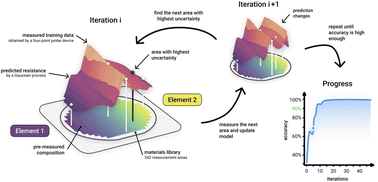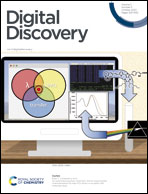Speeding up high-throughput characterization of materials libraries by active learning: autonomous electrical resistance measurements†
Abstract
High-throughput experimentation enables efficient search space exploration for the discovery and optimization of new materials. However, large search spaces, e.g. of compositionally complex materials, require decreasing characterization times significantly. Here, an autonomous measurement algorithm was developed, which leverages active learning with a Gaussian process model capable of iteratively scanning a materials library based on the highest uncertainty. The algorithm is applied to a four-point probe electrical resistance measurement device, frequently used to obtain indications for regions of interest in materials libraries. Ten libraries with different complexities of composition and property trends are analyzed to validate the model. By stopping the process before the entire library is characterized and predicting the remaining areas, the measurement efficiency can be improved drastically. As robustness is essential for autonomous measurements, intrinsic outlier handling is built into the model and a dynamic stopping criterion based on the mean predicted covariance is proposed. A measurement time reduction of about 70–90% was observed while still ensuring an accuracy above 90%.



 Please wait while we load your content...
Please wait while we load your content...